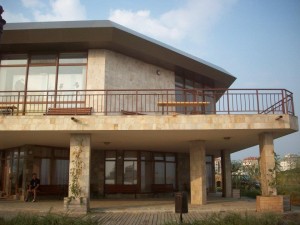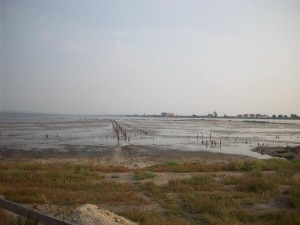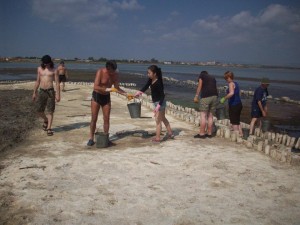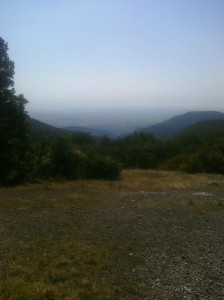
‘Conservation and restoration of habitats of globally threatened bird species in the area of Pomorie Lake and Sakar Mountains’
The Green Balkans was established in the 1970’s by members of the Bulgarian Ornithological Centre and Plovdiv University who came together to form a Natural History group that also took an interest into legislation regarding wildlife protection. Since this time the Green Balkans have built themselves up to a number of 4,500 members and have implemented over 110 nature conservation projects across Bulgaria (Green Balkans, 2010).
During the first week of the BTCV exchange programme, work was undertaken with the Green Balkans Volunteer group at Pomorie Lake. This site is situated to the East of Bulgaria, on the Black Sea coast. Pomorie Lake is a saline lagoon, which is separated from the Black Sea by a sand bar. The lake has a very high level of salinity, which means that specialised organisms and plant species, such as Brine Shrimp and Glasswort occur there (Green Balkans, 2011).
This saline habitat is a diverse one, and supports 71 seaweed taxa, 87 higher plants, 200 invertebrates, 7 fish species, 17 amphibian and reptile species, 268 bird species and 31 mammal species (Green Balkans, 2010). Bird species such as Sandwich, Common Tern and Avocet use the site as a nesting area. Nests are constructed on islands here, the islands are made using cement bases, and silt from the bottom of the lake.
Due to the weight of the large number of birds that had been nesting on the island, the height of it had dropped. It was the work of the BTCV group and the Green Balkan Volunteers to remove buckets of silt from the lake’s floor and deposit this on the island. This was achieved using a chain method, where two to three people would dig the silt from the bottom and place it into buckets. The buckets would then be passed along a line of people, and the people at the end would deposit the silt onto the needed place.
This work was completed in a week, and it was a good way of both undertaking the work, and of ensuring the two groups got to know each other. On completion of this the Green Balkan Volunteers returned home, and the BTCV exchange volunteers went on to Lalkovo Village.
Lalkovo Village is situated in the Elhovo region which is South Bulgaria, and is close to the Turkish Border.
Whilst in the Elhovo region the BTCV group were instructed that they should help with ‘Radio Telemetry’, this was the radio tracking of Imperial Eagle. The Green Balkans in this area fitted a number of radio trackers to Imperial Eagle chicks and have been monitoring their progress over the last few years. This helps gather useful information such as the territory behaviour, feeding activities and migration patterns. The information gathered by the team is inputted onto a large data base, using qualitative and quantitative information.
Undertaking Radio Telemetry required splitting into two teams, and each team tracking the same eagle at the same time, which would make the tracking more accurate. This would make it possible to pinpoint the location of the eagle, and to understand whether it’s flying or resting. Each team had a recording sheet and would answer the following questions:
• Time?
• Team Location (GPS)?
• Bird Location ?
• Flying or Resting?
• Is the bird visible?
• Do both teams have a signal?
• Is the signal good or poor?
• Further notes? (For example, any other species visible?)
The date, temperature, weather, and names of recorders would also be noted.
The afternoons were generally too hot to work in this region (as there wasn’t the coastal breeze that had been at Pomorie Lake) so the team slept during this time. In the evenings however, when the weather was cooler the Green Balkans and the BTCV team undertook nest building work for Imperial Eagle. The nests were made from local trees, using thick branches to form a base and thinner ones to create the nest shape on top. The nests would be placed in trees in the region, away from populated areas, and would hopefully attract some Imperial Eagle pairs. Once the eagles find the nests, they will add other materials to them, and make them bigger and more habitable.
During the time in this region, the BTCV group were also taken to the Sinite Kamani Nature Park to see the Griffon Vulture reintroduction programme. This involved importing Griffon Vultures from Spain, and carefully following a programme in which they are kept in an in-situ aviary for an amount of time before being released. The age of vulture determines how long it will be kept in the aviary for; if they are young they kept for longer. Their confinement in the aviary allows the vultures to become accustomed to their surroundings. This way they can see the good feeding and nesting grounds. Once released the Griffon Vultures are supplementary fed on carcasses, such as cattle and donkey.
I feel that during the time I have spent at Pomorie Lake and in the Elhovo region I have broadened my mind about conservation in Bulgaria. It was been interesting to experience how a different country undertakes conservation work, and to see the differences and similarities of these to the UK. I have worked on coastal sites in the UK, and I was grateful to experience another cultures coastal conservation activities. It was also interesting to see how becoming part of the European Union has lead to Bulgaria receiving further protection to their conservation sites, and how this had led onto extra funding. The people that I met from the Green Balkans were all very knowledgeable and passionate about wildlife and I hope that they are able to continue their great work in Bulgaria.




